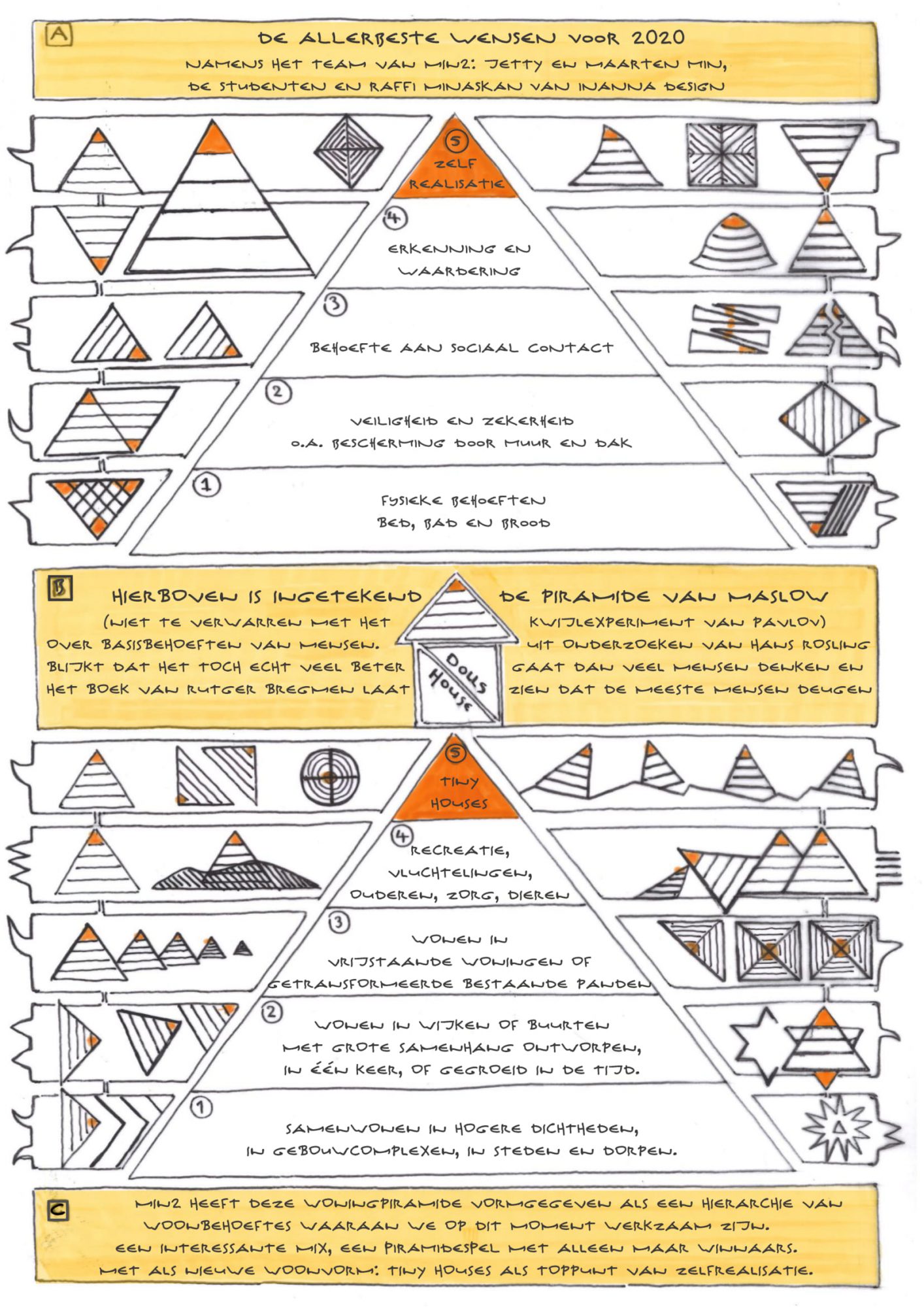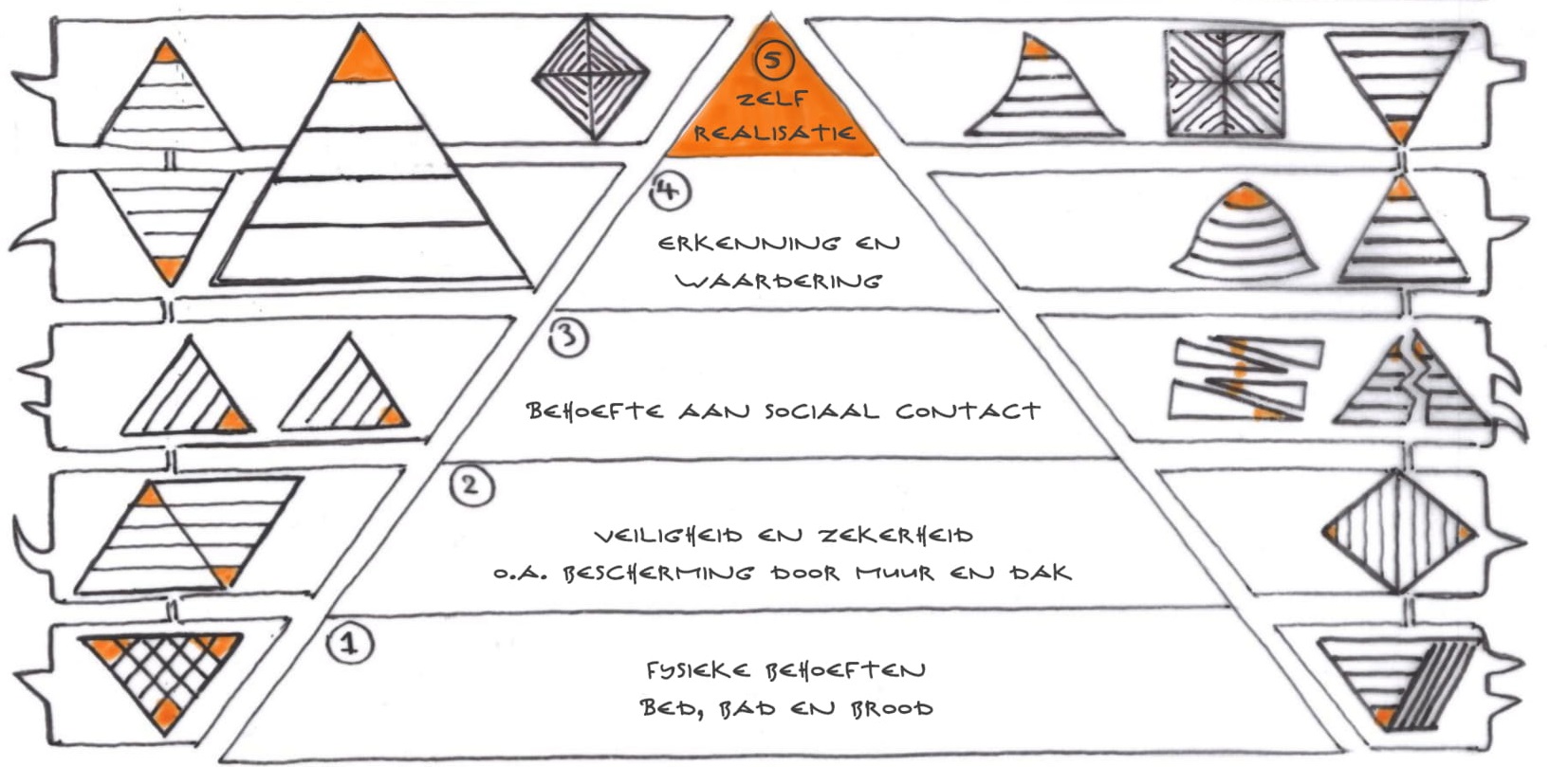I received this beautiful New Year’s wish from Jetty and Maarten Min Min 2 bouw-kunst and it made me think. What do we actually need in life? Everything comes together in the Tiny House movement. Based on the Maslow pyramid, Maarten shows very nicely in his sketch what role Tiny Houses play in fulfilling our needs.

We are fine here in the Netherlands, at least most of us are. Especially when compared to other countries. We can provide most of our basic needs. Although finding a roof over your head is not that easy in the current housing crisis (which is now almost as bad as immediately after the Second World War!). But no one has to sleep on the streets, if you don’t have the money to buy food you can go to the food bank, and although our health care system is not nearly as good as it has been, there is care at hand.
The Tiny House movement is about more than just residing. Small, sustainable and affordable housing allows you to live your life the way that you want. So that you can also provide for those other, less tangible basic needs.

Social contacts
When shelter, hygiene, food and water are taken care of, then the next step is social contact. Real contact with other people. Warmth, love, an arm around you when you need it. Tiny House locations are often organized around a community with multiple Tiny Houses together. It is also the wish of most (aspiring) Tiny House residents to live together with several houses, ideally five to ten. Like a kind of neighbors plus – a community that shares more with each other and looks more closely after each other than in the average residential area. Especially for the growing group of people living alone, this is a considerable desire: your own home with sufficient privacy, but also neighbors to whom you can turn for help or social contact.
Recognition and appreciation
This need is related to the previous social contact. I think we should not underestimate the need for recognition and appreciation. Everyone wants to be appreciated. We love to do meaningful work, hope that our friends appreciate our friendship, want to feel that we matter. Tiny House residents are mostly socially engaged and proactive people who like to give something back to society. Tiny House communities often organize activities or functions for their surroundings, such as Open House Days. Take Kleinhuizen, for example, which organized various green activities last year, with a real field party to top it all off. Or the de pioniers in Delft who are setting up a compost site for the neighborhood, so that no organic waste leaves the neighborhood anymore and everything is converted into beautiful compost that the residents can use in their gardens. These kinds of activities and, in addition, being there for your neighbors and helping each other when needed, contribute to providing this basic need.
Self-actualization
At the top of Maslow’s pyramid is self-actualization. When all other needs are met, we would like to develop ourselves. In order to be able to live in a Tiny House, you have to become active, as it doesn’t come easy. You learn a lot in the process of designing and building your own house and finding a residential location. Not least, you learn about yourself. Some people even build their own house – an ultimate form of self-actualization. We want to be able to decide for ourselves how we live and actively go out to realize our housing wishes. And, once you live in your Tiny House, it offers you the space to think about who you are and what you want in life. More financial space means more time and more freedom to organize your life the way you want. Self-determination is an important factor in the Tiny House movement.

Tiny Houses at the top
In Maarten’s pyramid you can see Tiny Houses at the top in the hierarchy of housing needs. His drawing is open to interpretation, but Maarten says:
“I mean that Tiny Houses are at the top of the house-building pyramid. It is the best, the most special. It is in accordance with Maslow, the ultimate self-actualization, and it is also a new species in the construction evolution.”
It is also intended to stimulate colleagues who do not yet think that way, he says. I like that :) I also like that Maarten indicates that things are not going as badly as people think and that most people are good, as Hans Rosling and Rutger Bregman, who are mentioned in the sketch, claim. I believe in that too. But striving for better is something human, as the pyramid shows. So, let’s strive for better by giving small, sustainable and affordable housing more space and giving people the space to shape their own living environment.


Leave a Reply